Ripley Entertainment Inc.'s Blog, page 332
July 10, 2018
CARTOON 07-10-2018
July 9, 2018
CARTOON 07-09-2018
July 8, 2018
Atomic Tourism: Vegas Visitors Watch Nukes Explode
Featured in Ripley's Believe It or Not!

Las Vegas is known as the city of lights and, at one time, that light was the glow of a nuclear detonation in the Nevada desert.
“It turned night into day.” -Allen Palmer, executive director for the National Atomic Testing Museum
Starting in 1951, the US Department of Energy began testing nuclear ordinances just 65 miles from the city of Las Vegas. At night, the glow of the bombs lit up the sky, and mushroom clouds could be spotted rising over the horizon during the day.
Atomic tourism drew people from all over to see these devices of ultimate destruction. Mushroom clouds showed up on billboards, in hairstyles, and even costumes. There was literal pageantry as Las Vegas named the official “Miss Atomic Bomb”.
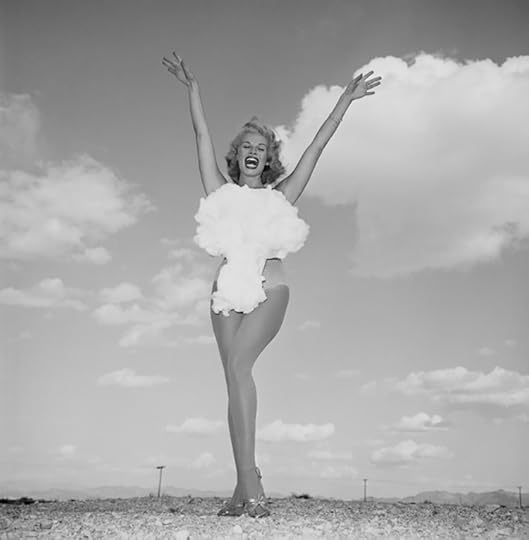
Courtesy Las Vegas News Bureau
Casinos jumped at the chance to use their roofs for exclusive atomic cocktail parties, and tourism officials posted guides on the best places to watch the bombs. Detonations were even announced in advance to ensure nobody missed them.
“The best thing to happen to Vegas was the atomic bomb.” – Benny Binion, casino owner
A Nuclear Society
Tests continued in the Nevada Desert until 1963, when the US signed a ban on above-ground testing. Despite the ban, over 900 bombs were tested outside the city between 1951 and 1992.
Ironically, all this spectacle and fascination was embedded in the midst of crippling worry over nuclear doomsday. During the same time, children were being told to hide under their desks in preparation for a nuclear attack. Schools even issued dog tags to children so they could be identified in case of an accident at the testing facility.

CC James Vaughan via Flickr
While the Vegas economy exploded with the bombs, so did concerns about dangerous radiation exposure. Soldiers viewing nuclear bombs showed significantly higher risks of cancer and a high chance of deformity in offspring, but military officials at the time said that residents of Las Vegas could just shower if they were exposed.
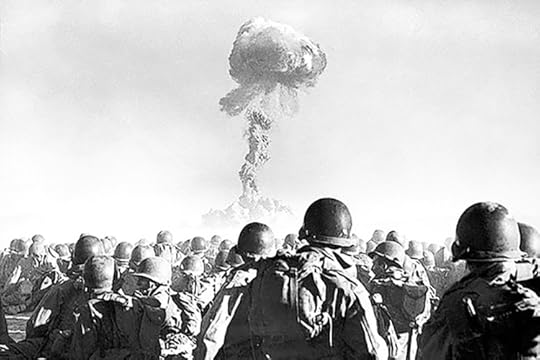
Courtesy Las Vegas News Bureau
CARTOON 07-08-2018
July 7, 2018
CARTOON 07-07-2018
July 6, 2018
This Parasitic Wasp Was Named After The Xenomorph
Featured in Ripley's Believe It or Not!

[July 1-7th, 2018] Driving burning cars, an allowance wage gap, a test board fails its own test, and a species of wasp named after aliens.
Chatty Stork
When an environmental group in Poland fitted a stork with a tracking collar they had no idea the effect sit would have on their cellular bill. The collar used a mobile phone tracker but seems to have fallen off in the stork’s 3,700-mile migration route. A man in Sudan found the collar and put its SIM card in his phone. The researchers got a bill for $2,700.

Fire Delivery
A man in Britain’s car caught fire this week, but instead of stopping to call for help, he kept driving, gunning for the fire department. He managed to make it, jumping out of the car asking for help. The firefighters put out the blaze but advises people against staying in their burning vehicles.

Exam Board Gets Its Own Question Wrong
Each year, thousands of British students take an English literature exam put out by the Oxford Cambridge and RSA Examination Boars, but this time it seems the test itself didn’t pass. In a question on Shakespeare’s Romeo and Juliet, they asked about Tybalt’s hatred for the Capulets. Tybalt himself was a Capulet and hated Montagues. The test board will be fined over $230,000 for the error.

Allowance Inequity
According to data analyzed by CBS from the popular chore site BusyKid.com, the gender wage gap extends all the way to household chores. A boy’s average allowance was $13.80 while a girl’s average was $6.71. Girls made less than half as much as boys on average!

Xenomorph Wasp
Scientists have named a new species of parasitic wasp in the forests of Australia. The Dolichogenidea xenomorph was named after the famous creatures in the Alien franchise of sci-fi horror movies. Just like the fictional aliens, the wasps inject their eggs into unsuspecting victims only for the larvae to later burst out.

Gateways To Hell Part I
Featured in Ripley's Believe It or Not!

Caves. Dorm rooms. A honky tonk. A volcano.
They’ve all been called—at one time or another—a gateway to Hell. Why? Sometimes it’s because people have seen otherworldly things with no explanation. Other times it’s been because explorers have gone in to look around and never come back. Still others have been told as much by God.
Here’s part one of the 10 places around the world people think are openings to Hell:
1: THE GATES OF GUINEE, New Orleans, LOUISIANA
Care for a little Voodoo lesson? According to their beliefs, the souls of the dead wait in Guinee before moving on to be reunited with their families. The seven Gates of Guinee correspond to the seven days after death, when the body is most closely related to its soul (and that’s also the most likely time when a dead body can be zombified, Voodoo practitioners say). In truth, these gates and their location are a secret, and it isn’t even truly known if they are real or imagined, though many claim they exist. Some say one of the gates is located at the grave of Voodoo priestess Marie Leveau.

2: PLUTO’S GATE, Southwestern TURKEY
Here, in the Phrygian City of Hierapolis, a sacred archaeological site was discovered in 2013 and matches an ancient description of a temple to Hell. Dedicated to Pluto, the Roman God of the Underworld, the site was described by writers as early as 64 B.C. Deadly vapors were said to come out of it, and they would kill any animals that dared to get too close. Contemporary archaeologists discovered that these early writers were correct. The structure, known as Pluto’s Gate, was built upon a cave that emits deadly gasses, even today. “This space is full of a vapor so misty and dense that one can scarcely see the ground,” wrote the Greek geographer and philosopher Strabo, who lived from 64/63 B.C. to 24 A.D. “Any animal that passes inside meets instant death. I threw in sparrows, and they immediately breathed their last and fell.”

3: CENTRALIA, Pennsylvania
In 1962, the people of Centralia, Pennsylvania, made a decision that would haunt them for eternity. Faced with cleaning up a 300-foot by 75-foot landfill, the townspeople decided to burn it, which wasn’t totally out of the question, considering how folks regularly burned their trash in those days. The only problem? The city was an old coal mining town, and it sat atop a series of caves. When the flames met the coal steam that rose from the caves, it set a series of fires all throughout the caverns underneath, making it impossible to control, much less ever put out. For years, the fires burned, cracking and melting streets, causing nearly every resident of the town to abandon their homes. The video game, Silent Hill, is actually based on Centralia, which many have come to now refer to as “Hell on Earth.”

4: MOUNT OSORE, Northern JAPAN
Located in the center of the remote Shimokita Peninsula in the Aomori Prefecture in northern Japan, Mount Osore is a Buddhist temple which sits in the crater of an active volcano. Japanese mythology claims that it is one of the gates to the Underworld. Translated, it means “Dread Mountain,” and you can understand why. It’s a barren wasteland, where the winds blow the stench of rotten eggs on everything around. It makes sense then, why souls might come here before moving on to Hell.

5: BOBBY MACKEY’S MUSIC WORLD In WILDER, Kentucky
In 1978, famous country/western musician Bobby Mackey purchased an old nightclub just south of Cincinnati, Ohio, and turned it into his personal honky tonk. What he didn’t realize at the time was how many people claimed the old site was supposedly haunted. No less than 29 people would go on to testify in sworn affidavits that the site was home to malevolent forces. They said spirits would push or touch patrons, and at least one person claimed to have been possessed by a demon. The structure’s history was a violent one, as it first served as a slaughterhouse, complete with a drainage well in the basement. That well, it was said, was a “gateway to Hell,” and according to local legend, Satanists would use it to drain the blood of their sacrifices. Bobby Mackey’s Music World was made more popular by the book “Hell’s Gate,” by Doug Hensley, which detailed his investigations into the site. The nightclub would go on to be featured on a handful of talk shows and paranormal programs, each reaffirming its legends and stories, though none have ever been proven. Still, every week, patrons come from far and wide to tour the site, and especially to go the basement, where they can investigate the famous well.

By Ryan Clarke, contributor for Ripleys.com
Source: Gateways To Hell Part I
Evel Knievel’s Death-Defying Descent
Featured in Ripley's Believe It or Not!

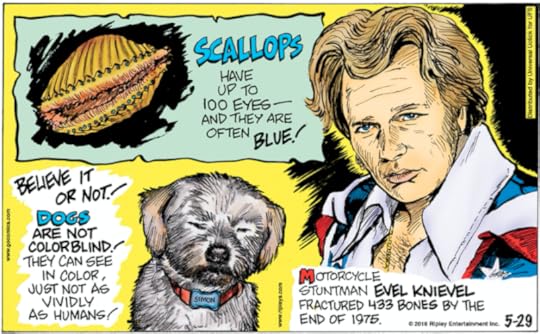
Believe it or not, Knievel fractured 433 bones by the end of 1975.
In Chicago, he attempted to jump over a 90-foot-long tank filled with 13 sharks. At his Washington motorcycle dealership, he soared over a twenty-foot-long box of rattlesnakes. In 1973, he managed to fly over 50 cars without a scratch.
He was Evel Knievel.
Clad in red, white and blue, Knievel was America’s daredevil. Known for his death-defying stunts, he is remembered just as much for his successes as he is his failures.
Snake River Canyon
When the United States government denied his request to jump over the Grand Canyon, Knievel scouted out an alternative location for one of his greatest attempts: Snake River Canyon in Twin Falls, Idaho.
Your typical motorcycle was not going to cut it. Snake River Canyon is, and was, about a quarter-mile wide and up to 500-feet deep in spots. In need of more power, Knievel hired a team of engineers to build him a steam-powered “rocket cycle.” Built and ready to go, Knievel hit the ramp on September 8, 1974.
While his rocket-powered vehicle made it across the canyon, the parachute attached to it deployed prematurely and winds dragged his craft back into the canyon. Knievel plugged, landing only a few feet away from Snake River. Strapped in tight, if he had landed in the water he would have likely drowned.
Like a champ, Knievel got up and walked away with only minor cuts and scrapes.
The Legend Lives
Forty-two years later, on September 16, 2016, stuntman Eddie Braun did what Evel did not—successfully jumping Snake River Canyon, believe it or not, in a craft built by the son of the man who built Kneival’s original rocket motorcycle.
He named it “Evel Spirit”.
CARTOON 07-06-2018
July 5, 2018
LOOK BEFORE YOU LEAP: The 100 Year History Of Stuntworkers
Featured in Ripley's Believe It or Not!

Kyle Weishaar is ready to jump out of a helicopter.
The 34-year-old is more than 70 feet in the air, waiting for his cue, as he has been asked to hurl himself into the ocean, where a boat is waiting to pick him up. His heart is pumping faster than normal but he’s focused on the task. He wants to get the stunt right, wants it to look good.
Because he’s doing it all in the name of great cinema.
And of course, he also wants to survive. Can’t go back now, he thinks.
“Whenever you hear of a stunt you’re qualified for, you’re like, ‘Hell, yeah I want to do it,’” says the stunt coordinator who’s been working in Hollywood for 10 years. “But it’s exciting and nerve-wracking at the same time. There’s always a certain amount of fear involved.”
And for Weishaar, who admits to having a “healthy fear of heights,” these kinds of stunts can be tricky. He wants to make sure he’s focused, and not too excited, because too much adrenaline can be a bad thing in this job. It can make people sloppy, which gets people hurt.
But the Kentucky native keeps his cool, makes his jump and nails the scene. In doing so, he survives the process and will go on to work another day.
“That’s the job,” he says. “You jump out of helicopters. You get thrown around. You get lit on fire. And you want to come back and do it some more.”
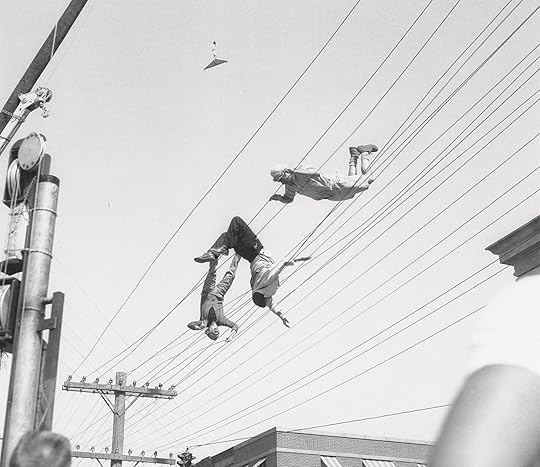
It’s a Mad, Mad, Mad, Mad World 1962, bouncing on power lines with Bill and Chuck Couch.
“DEFINITELY MORE DANGEROUS”
For more than 100 years, stuntworkers have been filling movies with amazing, hilarious and unbelievable scenes in the form of stunts, or—as they used to be called even as far back as the Silent Era—“gags.”
According to stuntworkers and historians alike, the industry and its workers have evolved while continuing to feature many of the same characteristics.
Weishaar is a good example. He originally went to college to major in mechanical engineering, but caught the acting bug, moved to Los Angeles and eventually utilized his athletic background in mountain climbing to become a stunt coordinator. It’s not entirely unlike the days in the early 20th century when movies were new, and casting professionals chose stuntworkers with circus backgrounds to come in and, for example, take a fall from a horse.
Now, Weishaar—who has doubled for stars like Armie Hammer and Alexander Skarsgard—has been shuttled to New York City, where he’s working on John Wick 3, starring Keanu Reeves. Weishaar is a student of the history of stuntwork, and he knows there are some aspects of the profession that will still surprise and amaze.
“It was definitely more dangerous back when it all began,” he says. “We know a lot more about technology, about movement and stunts, now than we used to. But make no mistake—it’s still dangerous.”
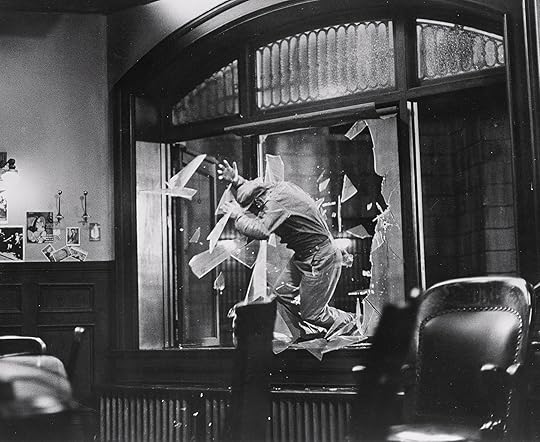
Billy Wilder’s Front Page 1974 – Crashing in, doubling Austin Pendleton.
Because the more the industry changes, the more it stays the same. Author Mollie Gregory can tell you that.
Gregory was sitting in her Los Angeles home when a woman knocked on her door and asked her to sign a copy of her latest book. The visitor happened to be a stuntwoman, and the two began talking about the profession. It soon became clear to Gregory she needed to write about the industry, and especially the history of female stuntworkers.
“It’s harder for women in this business, and it’s always been harder for women,” says Gregory, author of Stuntwomen: The Untold Hollywood Story.
In the book Gregory describes the Silent Era days when movies had just begun, and how those who could not get hired anywhere else—like Jews, immigrants, and women—could come to Hollywood and find work. By 1916, women were finding work as actresses and stuntworkers, starring in popular serials that changed the world of cinema.
“No one knew if movies would make any money,” she says. “But these serials were so popular, movies did start making money. Then the companies knew what they had.”
By 1930, the world of stuntpeople and movies began to change. Men took over, stunting for both men and women, and stunts became the focal point of cinema—the “engines,” as Gregory calls them. Simply, people came to watch what the stuntmen could do, and just as quickly, women were phased out.
The era of the stuntman began.
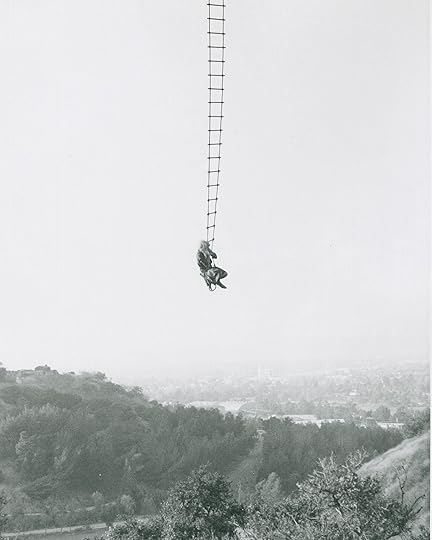
Sailing… with North Hollywood Federal in the far distance.
“This is an absolutely unique line of work,” Gregory says. “In the early days, movies were new. Planes were new. Everything was new. No one knew really what they were doing. There were no basic safety regulations. No one knew if a stunt would work until they tried it.”
Highlighting the danger, Gregory reported that in 1918-19, there were 1,052 temporary injuries among stuntpeople—and three deaths. “That’s a pretty high number of incidents,” she says.
Some of those who tried would become legendary names. Buster Keaton. Yakima Canutt. Harvey Parry. Hal Needham. Dar Robinson. Vic Armstrong. And as their stars shone ever brighter over the decades, more people came to California looking to become the next great stuntman.
“These are people who like the physical nature, like the risks—they don’t take unnecessary risks, they’re not stupid—but they like it,” Gregory says. “They are actors, and they are athletes, and they must be both. They are drawn toward the physical nature of the acting.”
‘JUMP TOO SOON’
Jesse Wayne was ready to run in front of the train.
But he had to be careful. The train would be running, too—at 30 miles per hour.
Doubling for 12-year-old Kurt Russell, the petite Jesse had to run in front of the train just as those chasing him—which included Ed Asner—get cut off by it.
“I decided to time it, and I figured one thing,” says Wayne, now 77 and living in Billings, Montana. “I decided I would much rather jump too soon rather than too late.”
It would sum up his career perfectly. Wayne, who doubled for actors and actresses for more than 40 years in Hollywood, has appeared in more than 500 television shows and feature films. He remembers watching Disney’s Song of the South as a child in 1946 and describes his career in the autobiographical Confessions of a Hollywood Stunt Man. “That was when I knew I wanted to be in showbiz,” he says.
A natural athlete who practiced gymnastics, he worked in television for years, but by 1969 he was in Hollywood doubling for Mickey Rooney.
There, he did it all. He fought. He leaped from tall buildings. He set himself on fire. Once he even suffered second-degree burns when a special effects coordinator lit him before lighting the rest of the room. But he feels lucky to have made it out in one piece.
“Most stunt people believe in guardian angels,” he says. “I sure do. You know, once I had to jump from one building to another over an alley. You just hoped you made it. You do it, and you come back another day.”
By 1970, women began to again fight for inclusion into the stunt world, and slowly, they formed their own legendary names. Wendy Leech. Michelle Yeoh. Tammie Baird.

Stunt double Jessica Harbeck with actor Laura Haddock. Credit: Debbie Wong/Shutterstock
More and more men and women made their way to Hollywood to become stuntpeople.
Still, the question remained: Why would they really want to?
‘CLAIM TO FAME’
Greg Fitzpatrick stops to think when he considers the question.
“I just don’t know about it,” he says. “You asked what my ’Claim to fame’ is. That’s not the best way to put it. I’m actually being someone else, so it’s not really mine.”
But Fitzpatrick himself actually has many claims to fame. He has been a stuntman in Hollywood for more than 20 years. He has doubled Robert Downey Jr. in Iron Man and Ben Stiller for most of his career.
The former athlete has risen to the heights of his profession, but he realizes that as a stuntman, he must be unseen. It’s an irony that doesn’t escape him.
“We’re anonymous,” he says. “We’re only recognized within our industry.”
He has jumped from tall buildings and jumped into water. He has won two World Stunt Awards. But he has also seen numerous friends injured or killed in this business over the years.
So why continue to do it?
“It’s really cool,” he says, laughing. “I love to perform. I’m an athlete, and it’s like being a professional athlete. But there are very few times when I’m not frightened doing what I do.”
A successful stuntworker, like one who doubles a famous actor, can earn up to $500,000 a year, Fitzpatrick says. They’ve come a long way. The 1959 rate paid them $80 per day. Today, that number is up to $995. But it’s obvious—they’re not in it to make big money.
“You do it because it’s in your blood,” Fitzpatrick says.
Gregory agrees. “It’s about guts and attitude,” she says. “In the beginning, it was a trial and error process that, if you had the guts to try it, you could be famous.”
Slowly, the industry has turned back around, becoming more open to safety and stuntwomen. More female action roles have led to more female stuntwork. “We’ve got a ways to go, but we’re progressing,” Gregory says.
Yet again, as much as things change, from technology to safety, many things in stuntwork remain the same. And after more than 100 years, one thing will always be certain.
“Or course, it’s still very dangerous,” Fitzpatrick says. “And it always will be.”
By Ryan Clark, contributor for Ripleys.com.
Source: LOOK BEFORE YOU LEAP: The 100 Year History Of Stuntworkers
Ripley Entertainment Inc.'s Blog
- Ripley Entertainment Inc.'s profile
- 52 followers








